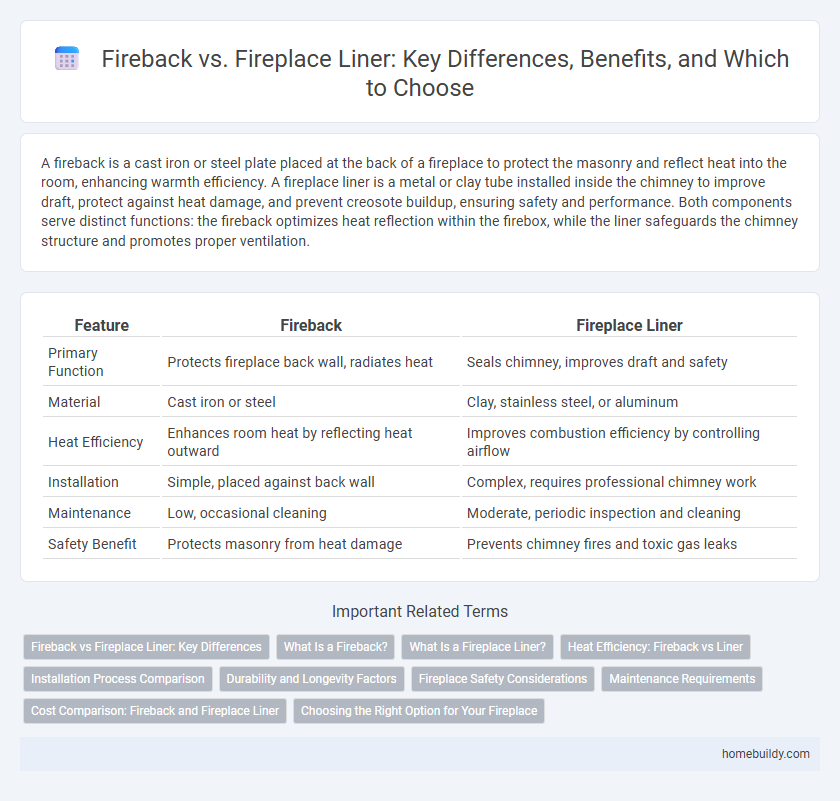A fireback is a cast iron or steel plate placed at the back of a fireplace to protect the masonry and reflect heat into the room, enhancing warmth efficiency. A fireplace liner is a metal or clay tube installed inside the chimney to improve draft, protect against heat damage, and prevent creosote buildup, ensuring safety and performance. Both components serve distinct functions: the fireback optimizes heat reflection within the firebox, while the liner safeguards the chimney structure and promotes proper ventilation.
Table of Comparison
| Feature | Fireback | Fireplace Liner |
|---|---|---|
| Primary Function | Protects fireplace back wall, radiates heat | Seals chimney, improves draft and safety |
| Material | Cast iron or steel | Clay, stainless steel, or aluminum |
| Heat Efficiency | Enhances room heat by reflecting heat outward | Improves combustion efficiency by controlling airflow |
| Installation | Simple, placed against back wall | Complex, requires professional chimney work |
| Maintenance | Low, occasional cleaning | Moderate, periodic inspection and cleaning |
| Safety Benefit | Protects masonry from heat damage | Prevents chimney fires and toxic gas leaks |
Fireback vs Fireplace Liner: Key Differences
Firebacks are heavy cast iron plates placed at the back of a fireplace to protect the masonry and radiate heat into the room, while fireplace liners are metal or ceramic systems designed to create a safer and more efficient flue for smoke exhaust. Firebacks primarily enhance heat retention and protect the firebox, whereas fireplace liners improve draft, prevent chimney deterioration, and ensure compliance with modern building codes. Choosing between a fireback and a fireplace liner depends on whether the priority is heat radiation or chimney safety and performance.
What Is a Fireback?
A fireback is a cast iron plate placed at the back of a fireplace to protect the masonry from heat damage and to radiate warmth into the room. Unlike a fireplace liner, which seals and improves the draft of the chimney system, a fireback enhances heat efficiency and adds durability to the firebox structure. Firebacks also serve as decorative elements, often embossed with intricate designs, combining functionality with aesthetic appeal.
What Is a Fireplace Liner?
A fireplace liner is a protective metal or clay tube installed inside an existing chimney to improve safety and efficiency by preventing heat transfer to combustible materials. Unlike a fireback, which is a cast iron plate placed inside the fireplace to reflect heat into the room, a fireplace liner ensures proper ventilation and structural integrity of the chimney. Fireplace liners are essential for reducing creosote buildup, minimizing the risk of chimney fires, and enhancing the overall performance of wood-burning appliances.
Heat Efficiency: Fireback vs Liner
Firebacks excel in heat efficiency by absorbing and radiating heat back into the room, improving warmth retention compared to traditional fireplace liners. Fireplace liners primarily protect the chimney structure while offering limited impact on radiant heat output. Choosing a fireback enhances overall heat distribution and increases energy savings during use.
Installation Process Comparison
Firebacks are generally easier to install than fireplace liners because they typically require no specialized tools or extensive modifications to the existing fireplace structure. Fireplace liners demand precise measurements and professional installation to ensure proper fit, safety, and efficiency, often involving chimney relining and sealing. The fireback installation mainly involves positioning the cast iron piece at the back of the firebox to reflect heat, whereas liners require comprehensive work to protect the chimney and improve ventilation.
Durability and Longevity Factors
Firebacks, typically made from cast iron or steel, offer superior durability due to their solid construction and resistance to heat damage compared to fireplace liners. Unlike liners that may warp or deteriorate under prolonged exposure to intense fires, firebacks maintain structural integrity and enhance heat retention over time. Their robust design contributes to a longer lifespan, providing consistent protection and efficiency in wood-burning fireplaces.
Fireplace Safety Considerations
Firebacks, typically made of cast iron or steel, serve as a protective barrier against heat and flame damage to the back wall of a fireplace, enhancing overall safety by preventing potential structural damage and reducing the risk of fire hazards. Fireplace liners, often constructed from stainless steel or aluminum, are designed to improve draft efficiency and contain combustion gases, significantly minimizing the chances of smoke infiltration and toxic fume exposure indoors. Choosing a fireback or fireplace liner based on material durability, heat resistance, and correct sizing contributes to safer fireplace operation, ensuring compliance with fire safety standards and reducing maintenance risks.
Maintenance Requirements
Firebacks require minimal maintenance, usually involving occasional cleaning to remove soot and ash buildup, preserving their decorative cast iron or steel surface. Fireplace liners demand more frequent inspections and cleaning to prevent creosote accumulation, which is crucial for safety and efficiency in venting smoke. Regular maintenance of fireplace liners ensures proper airflow and reduces fire hazards, while firebacks primarily protect the rear wall and enhance heat radiation with less upkeep needed.
Cost Comparison: Fireback and Fireplace Liner
Firebacks typically cost between $200 and $500 depending on the material and design complexity, offering a durable and decorative solution that reflects heat efficiently. Fireplace liners, however, range from $1,000 to $3,500 due to the materials used and installation requirements, providing enhanced safety and improved heat retention by protecting the chimney structure. Choosing between a fireback and a fireplace liner depends on budget constraints and the need for either aesthetic heat reflection or comprehensive chimney protection.
Choosing the Right Option for Your Fireplace
A fireback is a cast iron plate installed at the back of a fireplace to protect masonry and radiate heat into the room, enhancing efficiency and longevity. Fireplace liners, typically made from stainless steel or aluminum, provide a heat-resistant barrier that improves safety by preventing heat transfer to surrounding combustible materials. Choosing between a fireback and a fireplace liner depends on factors like the fireplace's construction, desired heat reflection, and maintenance preferences.
Fireback vs Fireplace Liner Infographic

 homebuildy.com
homebuildy.com